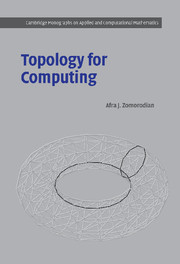4 - Homology
Published online by Cambridge University Press: 19 August 2009
Summary
The goal of this chapter is to identify and describe a feasible combinatorial method for computing topology. I use the word “feasible” in a computational sense: We need a method that will provide us with fast implementable algorithms. Our method of choice will be simplicial homology, which complements our representation of spaces in simplicial form. Homology utilizes finitely generated Abelian groups for describing the topology of spaces. Fortunately, we fully understand the structure of these groups from Chapter 3. We may now define homology easily, and even venture confidently into some advanced topics.
But first, I need to justify the choice of homology, which is weaker than both forms of topological classification we have seen earlier. I do so in the first section of this chapter. I devote the next section to the definition of simplicial homology, a quick history of the proof of its invariance, and the relationship of homology and the Euler characteristic. In the final section, I examine the Universal Coefficient Theorem in order to develop a faster procedure for computing the topology of subcomplexes of ℝ3.
I borrow heavily from Hatcher (2001) and Munkres (1984) for the content of this chapter. I am also influenced by great introductory books in algebraic topology, including Giblin (1981), Henle (1997), and, my first encounter with the subject, Massey (1991).
- Type
- Chapter
- Information
- Topology for Computing , pp. 60 - 82Publisher: Cambridge University PressPrint publication year: 2005



